MT-1
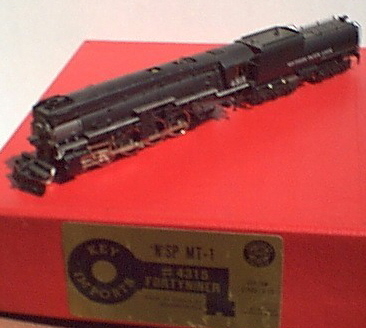

MT-4


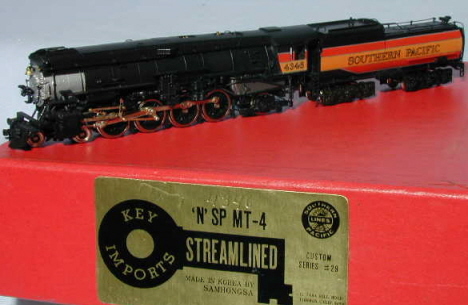
MT-5



MT-1


MT-4



MT-5



Introduced: 1985 (MT-1 / MT-4), and 1998 (MT-4 / MT-5)
As noted above, there have been a couple of different releases of these SP Mountains -
First run (1985, SER #29)
- MT-1 #4313 Shasta
- MT-1 #4315 49er
- MT-4 #4353 Sacramento Green
- MT-4 #4348 Valley Daylight
Second run (1998, SER #124 and #125)
- MT-4 #4364 Sacramento Green
- MT-4 #4363 Shasta (w/ plow & ears)
- MT-4 #4354 Skyline (black w/ silver smokebox)
- MT-4 #4361 Skyline (daylight)
- MT-5 #4376 Sacramento Green
- MT-5 #4369 Shasta (w/ plow & ears)
- MT-5 #4370 Skyline (semi-streamlined)

The chassis is all metal and quite light (with most of the actual heft being provided by the boiler shell). The motor is a closed-sided / 5-pole Faruichi (Japan). The driveshaft is plastic. Right-rail pickup is provided by all four right-side drivers (there are no traction tires). Left-rail pickup is provided by the four left-side tender wheels. All the rest of the wheels are electrically neutral. Current is transferred from the tender to the engine by way of a stiff metal wire on the drawbar (a notoriously unreliable scheme). Only the second set of drivers (counting from the front) are geared, with the rest of the drivers being turned solely by the valve gear. The main gear / worm gear assembly is mounted on a coil spring, allowing for a bit of up and down play. All gearing is metal. A dummy (non-operational) knuckle coupler is mounted to the pilot. There is no coupler on the tender, although a Micro-Trains friendly coupler pocket is provided. There is no lighting. Wheels are low-profile, so no problems on Code-55 rails.
Performance is impressive. Throttle response is absolutely smooth and slow-speed creep is exceptional. The top-end speed is quite reasonable. It runs relatively quietly, although it does have a slightly annoying / toyish buzz to it (which I assume is driveshaft related). And although noticeable, it's certainly not horrible. And who knows? Perhaps it will go away after a bit of running-in.
Pickup is surprisingly good, especially given the drawbar situation. I've had more than my fair share of Samhongsa steamers that barely ran due to the tender's inability to reliably conduct its current to the engine. Not so here, though. Apart from an occasional hitch / stutter, pickup is quite reliable. Yes, non-powered turnouts can sometimes cause a stall if you try to creep through them at extremely low speeds. But overall, there's just not too much to complain about here. Given Samhongsa's track record in this regard, maybe I just got lucky.
I'd say 11" is pretty much your minimum operating radius with this locomotive. Anything sharper than that and it's going to be derailing all over the place.
Overall, these are great looking models than run quite well. No, not Kato "well", but definitely solid enough to join an operational fleet.

I've never owned a second-run 4-8-2, but I'm told the major differences between the two releases are in the motor and motor mountings.
As noted above, the first run 4-8-2's have a Furuichi 5-pole motor. The motor is fixed to the frame by its mounting bracket and cannot move up and down. No provision exists for connecting the motor and gear box (in order to prevent the gear box from rotating).

Second run models have a Faulhaber #1319 coreless motor. The motor is bracket-mounted on a "torque arm" (which connects the gear box to the motor). The torque arm is spring-mounted to the frame, allowing the motor to move up and down in concert with the sprung gear box. The torque arm also prevents the gear box from rotating, thus maintaining good alignment between the worm gear shaft and the motor shaft.
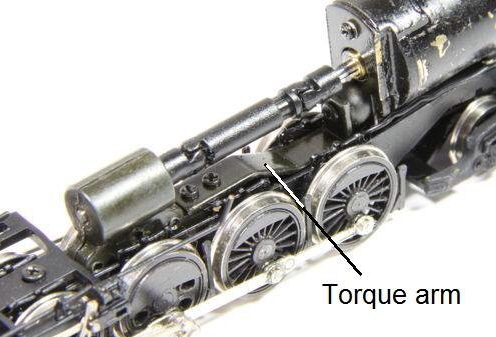
In addition to the aforementioned mechanical differences, the second run 4-8-2's also have working headlights. I'm told that this newer version runs even better than the older one - in fact, right up there with the all-time greats of N scale brass.
Trivia - some of the second run boxes are mislabeled as being 4-8-8-2's -
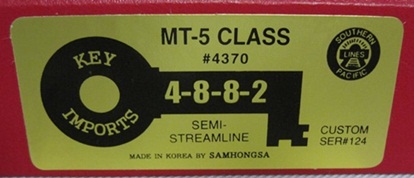
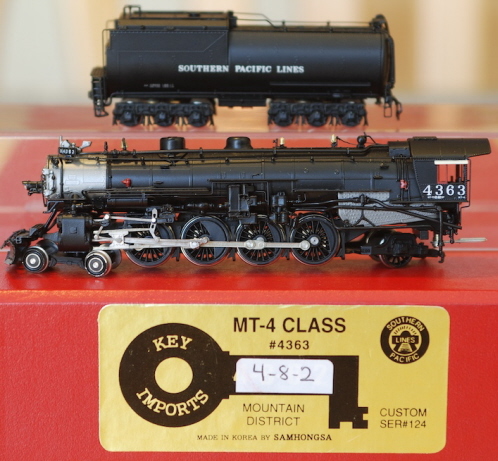
From what I've seen, the ones with the incorrect labels are designated as SER #124, whereas the corrected ones are designated as SER #125. However, despite the different SER #'s, they're all from the same production run.
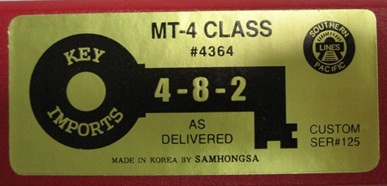
To remove the engine shell, unscrew the two screws on the back (cab) end. Next, remove the screw that holds the pilot truck to the chassis. The shell should lift off readily at that point. Just be careful disengaging the front of the shell from the chassis. A steam line and two handgrabs need to be worked loose from where they plug into the chassis.
Grade: B (for the first run). And presumably an "A" for the second run (although I've never actually tried one)